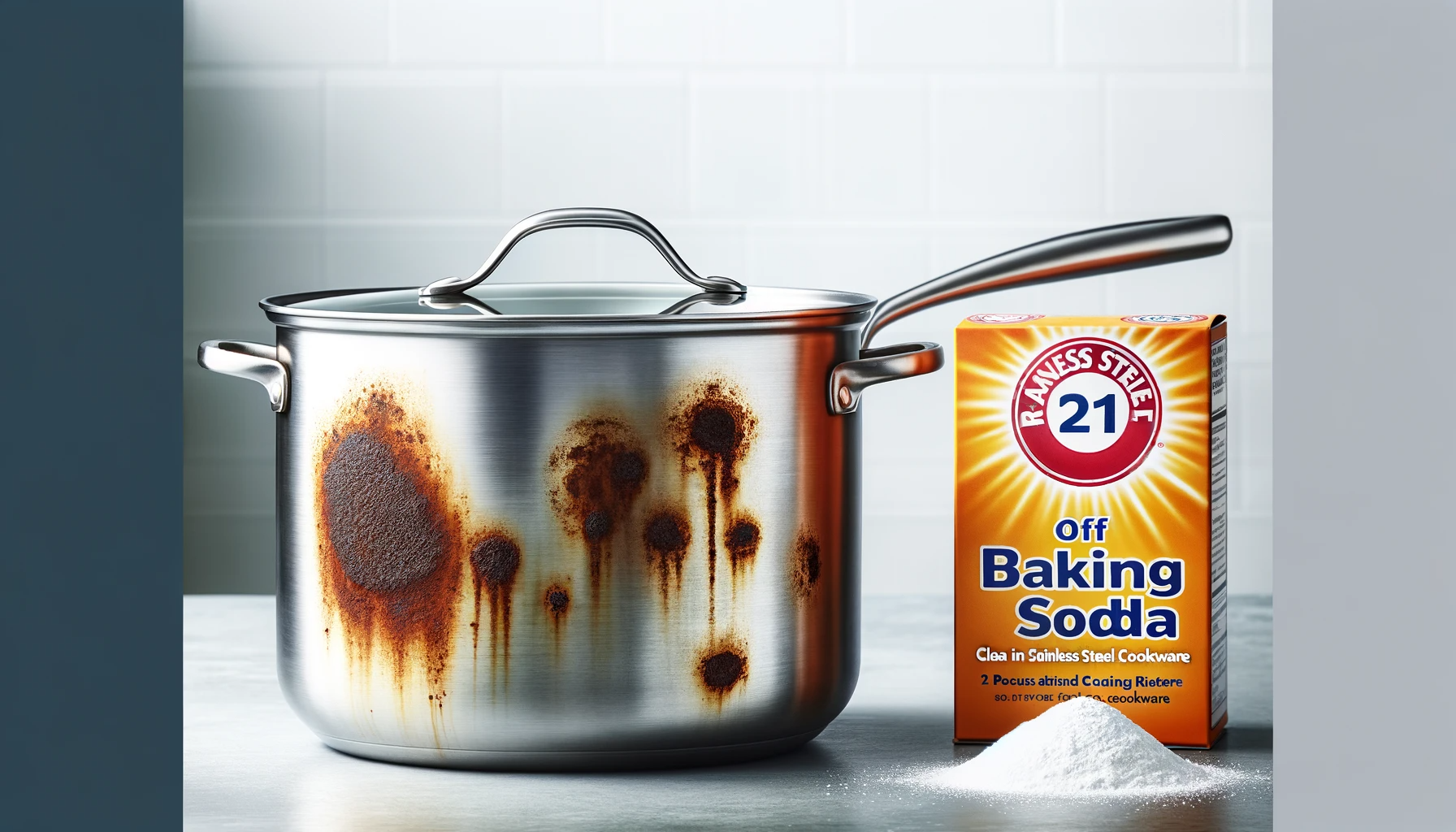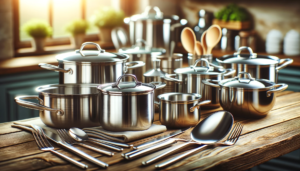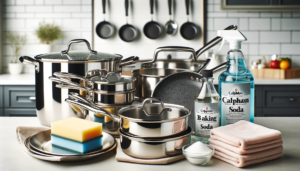If you’ve noticed unsightly rust stains marring the surfaces of your stainless steel cookware, don’t despair.
Removing them is very doable with the right techniques and a little elbow grease.
From household staples like baking soda to commercial cleaners containing rust-fighting oxalic acid, many common products can safely dissolve and lift away stainless steel rust stains without damaging your valuable pans.
Let’s dive in to some of the easiest and most effective options for cleaning away tough rust from stainless steel pots, pans, and appliances.
How to Clean Rust Off Stainless Steel Cookware?
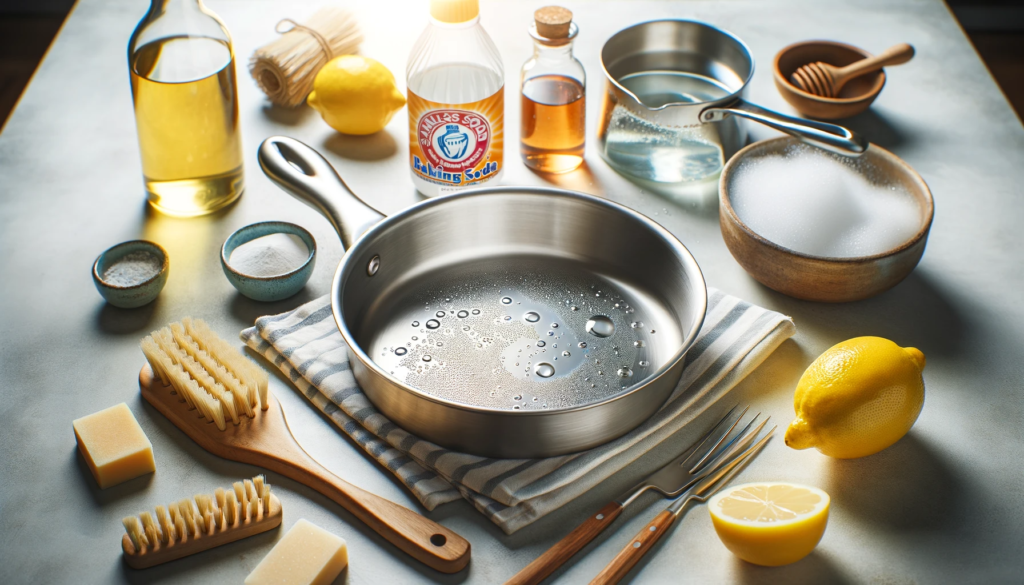
Rust can be cleaned off stainless steel cookware through abrasive yet gentle scrubbing using baking soda and water pastes or specialty stainless steel cleaners containing oxalic acid.
These methods safely dissolve rust bonds so the stains can be removed without damaging the pans.
Vinegar, lemon juice, and Magic Erasers also work.
We’ll explore the best cleaning options in more detail below.
Assess the Level of Rust
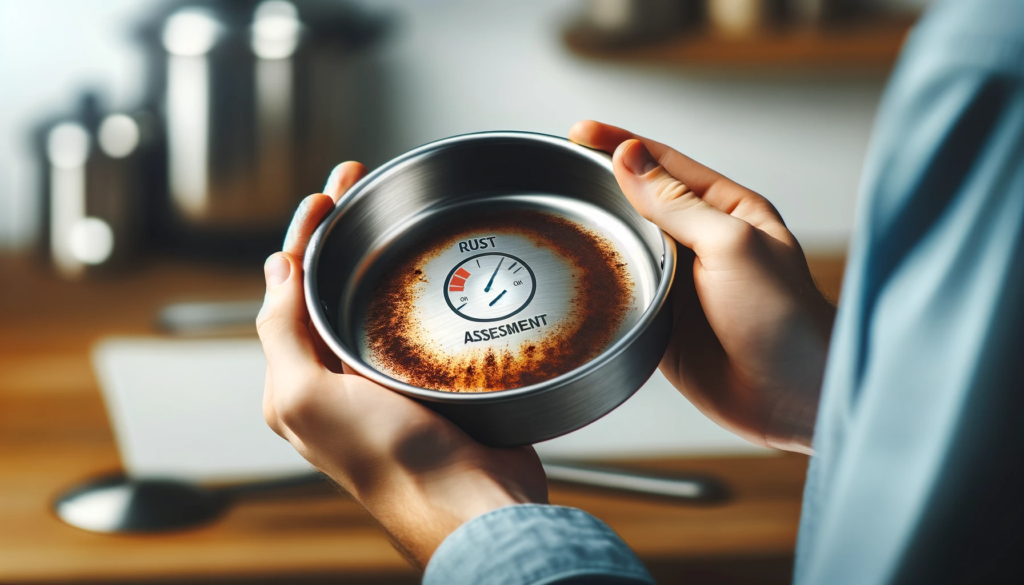
It is important to examine your stainless steel pans to determine how much rust has formed before beginning the cleaning process.
Rust stains that are just on the surface will require less aggressive cleaning methods compared to rust buildup that is thicker and covers more area.
Carefully look over the entirety of your stainless steel cookware, paying special attention to areas prone to rust like the bottoms and around welded areas or rivets.
Determine whether you are dealing with minor surface stains or more significant rust corrosion.
This assessment will guide which cleaning method will work best to remove rust and restore your stainless steel.
Try Baking Soda and Water
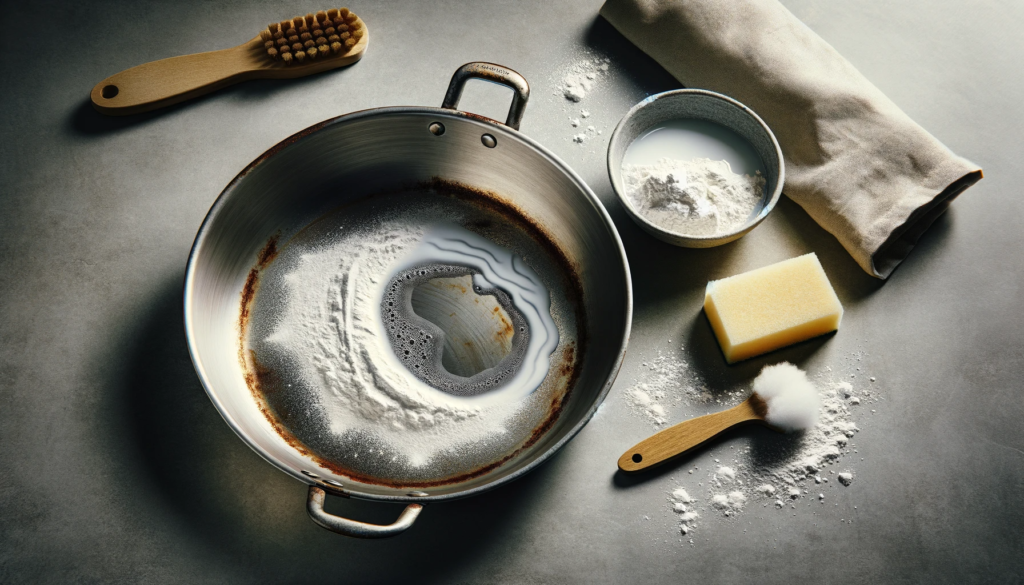
One of the gentlest ways to tackle surface level rust stains on stainless steel cookware is to make a paste with baking soda and water.
The baking soda has mild abrasive properties which can help lift rust off the steel surface when used in a paste.
To use this method, mix a few spoonfuls of baking soda with just enough water to form a spreadable paste.
Apply the baking soda paste onto the affected areas of your stainless steel pots and pans using a soft cloth or sponge.
Let the paste sit for two to three minutes to allow the baking soda time to start interacting with and lifting the rust.
After letting it sit, use your cloth or sponge to gently scrub the rusted areas in order to remove rust that has been lifted by the paste.
Rinse thoroughly once finished scrubbing.
Check to see if any rust remains, and spot clean those areas again if needed.
Baking soda mixed with water makes an effective rust removing paste for light surface stains.
Use Vinegar or Lemon Juice
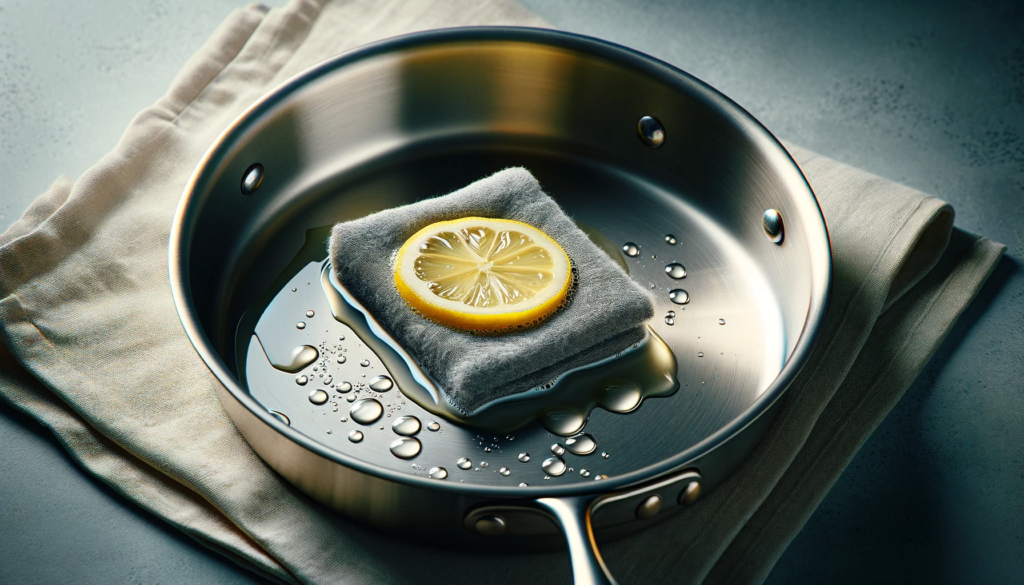
In addition to baking soda, mild acids like vinegar and lemon juice can also help dissolve and remove rust from stainless steel surfaces.
These acids break down the rust bonds so the stains can be dissolved and wiped away more easily than scrubbing alone.
To utilize this cleaning method, soak a wash cloth, paper towel, or sponge in undiluted white vinegar or freshly squeezed lemon juice.
Place the soaked acid applicator directly onto the affected rust stains, ensuring contact with all stained area.
Allow the vinegar or lemon juice to sit for approximately thirty minutes.
As it sits, the acid will react with the rust bonds and loosen the stains.
After letting it soak for half an hour, check on the stains and wipe.
The rust should now rub off with some light scrubbing using your applicator or a soft bristle cleaning brush.
Thicker rust buildup may take a few applications and soaking sessions to fully remove.
But vinegar and lemon juice provide an effective stain dissolving pre-treatment for stainless steel cookware.
Make a Stainless Steel Cleaner
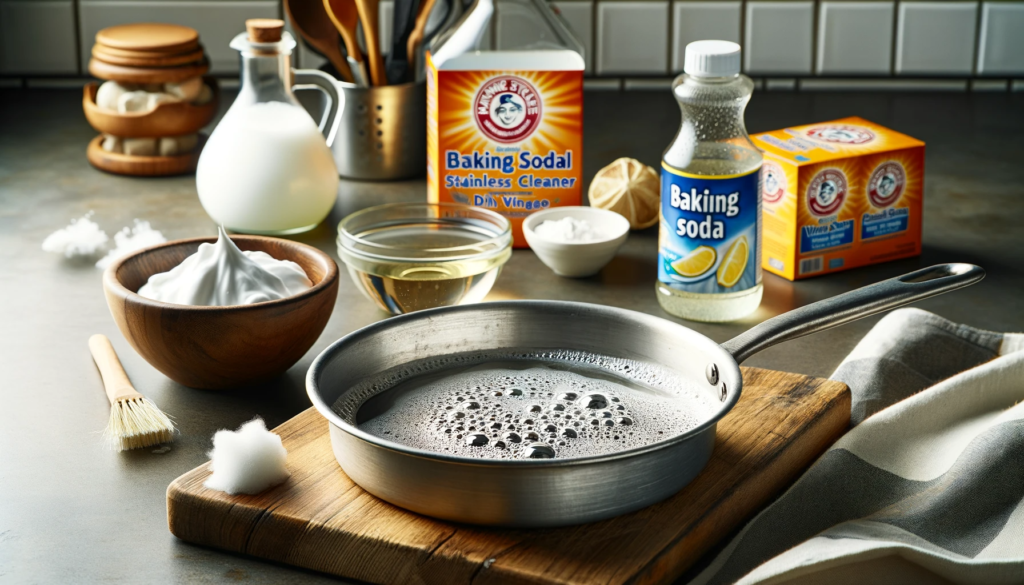
For a multi-purpose stainless steel cleaner that combines some abrasive power along with rust-fighting acidity, mix dish soap with baking soda and either vinegar or lemon juice.
The resulting solution takes advantage of the rust-removing power of acids along with some gentle scouring capability from the baking soda.
To mix this cleaner, add about a quarter cup of baking soda and a quarter cup of vinegar or lemon juice into a mixing bowl.
Pour in one to two teaspoons of mild dish detergent like Dawn or Palmolive.
Mix the ingredients together thoroughly until a thick, spreadable paste forms.
Using a soft sponge or cloth, apply the paste to rusted areas of your stainless steel, gently scrubbing to remove rust stains.
The integrated acidic ingredients will help dissolve rust bonds while the baking soda lightly scrubs without damaging the finish of properly made stainless steel cookware.
Make sure to rinse cleaned areas thoroughly once finished.
Repeat if any residual stains remain.
This homemade cleaner combines cleaning power with rust removal for stainless pots and pans.
Use Stainless Steel Polish or Cleaner

In addition to do-it-yourself cleaners, there are also specialty stainless steel polishes and cleaners available that make removing stubborn rust easy.
Products like Bar Keepers Friend or Bon Ami are designed specifically for cleaning stainless steel without damaging the delicate finish or metal itself during cleaning.
These pre-made cleaners integrate abrasives that are safe yet effective at scrubbing away tough stains.
They also often contain oxalic acid which helps dissolve and lift rust so it can be wiped away.
To use one of these specialty stainless steel cleaners, follow the directions listed on the product packaging.
In most cases, you will activate the cleaner using a damp sponge or cloth, directly apply onto affected areas, allow one to two minutes for it to interact with stains, then gentle scrub to remove rust.
These cleaners save you the work of mixing up homemade pastes.
And lend the power of oxalic acid for dissolving tough rust stains on stainless steel cookware and surfaces while containing safe abrasives.
Try Using a Magic Eraser
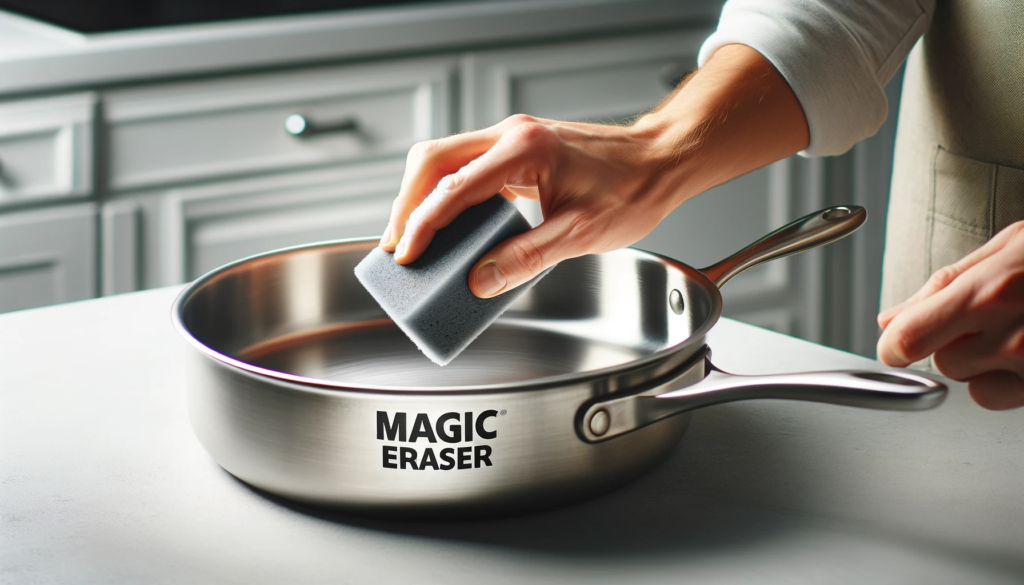
Magic Eraser cleaning blocks made from melamine foam offer another way to attack tricky rust stains on stainless steel pots, pans, and appliances.
The porous structure of the melamine foam provides a gentle yet abrasive surface that helps lift contaminants through direct physical interaction rather than harsh chemical cleaners.
Simply wet a Magic Eraser, then use it to gently scrub areas of rust staining on your stainless steel cookware.
The eraser will abrade both the rust and steel surface which allows the blemishes to be rubbed away.
Take care not to overly scrub or apply too much pressure, as aggressive scouring can lead to permanent scratching of the stainless steel finish.
Applied properly, Magic Erasers can safely remove pesky rust stains without damaging cookware.
Their fine abrasive quality makes them ideal for delicate surface cleaning jobs.
When in Doubt, Re-season
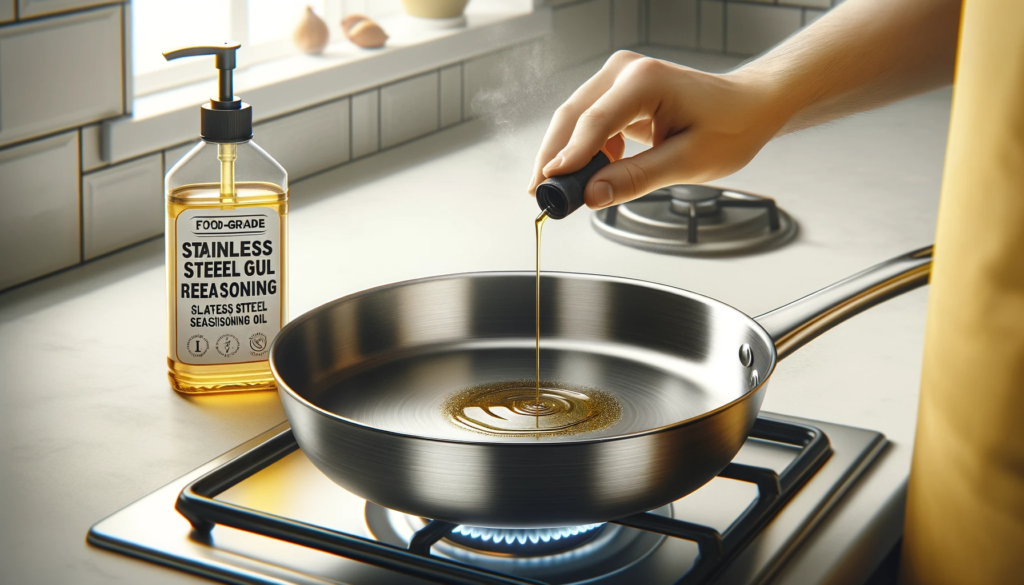
If you have attempted all other rust removal methods to no avail, or if your stainless steel pans have extensive corrosion damage causing pitting and texture changes, you may need to re-season the cookware after cleaning.
While stainless steel itself does not need traditional seasoning the way cast iron cookware does, re-seasoning stainless steel pans with corrosion damage can help protect and smooth the cooking surface after other cleaning attempts.
There are specialty food-grade stainless steel seasonings, like Caron & Doucet Stainless Steel Seasoning Oil, which provide a protective coating and help prevent future contamination issues.
After removing as much rust and corrosion as possible, wash and thoroughly dry your stainless steel pan.
Then apply a thin coating of seasoning oil following packaging directions, heating the pan and oil to evenly distribute until the metal surface turns a pale gold color.
This can protect and smooth the cooking surface.
Re-seasoning in stubborn cases of rust corrosion may help preserve and protect your stainless steel pans.
Conclusion
In conclusion, rust stains on stainless steel cookware can often be removed with common household products like baking soda, vinegar, and lemon juice.
When simple cleaning methods fail, specialty stainless steel polishes containing oxalic acid offer a commercial solution for dissolving stubborn rust bonds.
And for pans with extensive corrosion damage, re-seasoning provides a way to protect and smooth degraded cooking surfaces after cleaning efforts.
With this variety of options available, from gentle scrubbing methods to heavy duty rust removers, you can safely restore stained stainless steel pots and pans while retaining performance and appearance.
